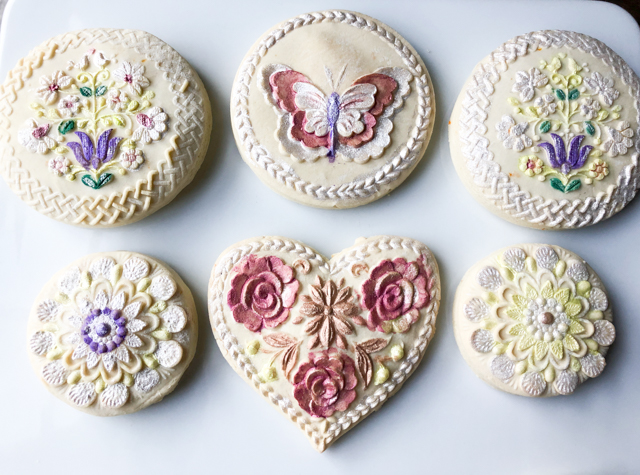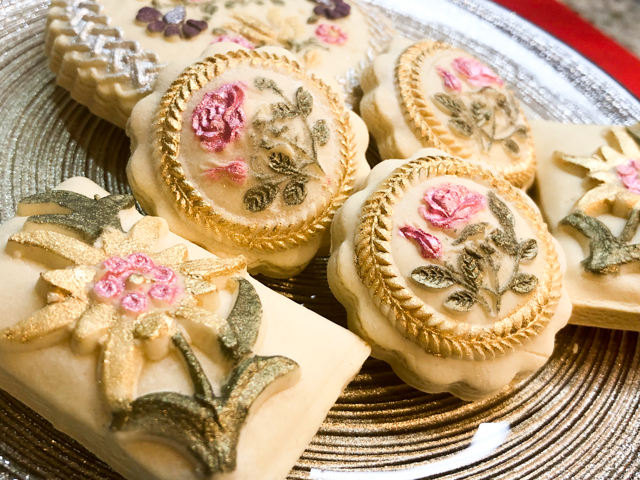
My love for macarons should be quite obvious, but there’s something about Springerle Cookies that speaks straight to my soul. These cookies, not unlike macarons, have been around for centuries. In terms of flavor, they are a lot more strict, as there is no filling to play with. But they are so elegant, so magical, and the anise oil makes them unique. Oddly enough I don’t like licorice but find the anise flavor of Springerle quite enticing. I share with you one authentic recipe for these cookies that is a bit of a labor of love, and also time-consuming, as the cookies have to dry for a couple of days before baking. But, if you want to just use those beautiful molds in a simpler recipe, I’ll share my favorite also. A special thank you to my friend Margie, who sent me two beautiful molds, and perhaps not intentionally, turned me into a Springerle-mold-addict.

SPRINGERLE COOKIES
(traditional recipe, based on The House on the Hill)
for the cookies:
1/4 teaspoon baker’s ammonia (Hartshorn)
1 tablespoons milk
3 large eggs, room temperature
360g powdered sugar
57g (1/4 cup) unsalted butter, softened but not melted
1/4 teaspoon salt
1/4 teaspoon of anise oil
454g sifted cake flour (I used Softasilk)
grated rind of orange
for the glaze (optional):
240g powdered sugar
3 tablespoons water
1/2 teaspoon flavoring of your choice (I used vanilla)
pearl dust colors and lemon extract
Make the cookies: Dissolve baker’s ammonia in milk and set aside (avoid the temptation to take a sniff, you will regret it). Beat eggs until very thick, this will take from 10 to 15 minutes. Slowly beat in the powdered sugar, then the softened butter. Add the the mixture of baker’s ammonia and milk, salt, anise oil and orange zest.
Gradually beat in as much flour as you can with the mixer, then stir in the remainder of the flour to make a stiff dough. Turn onto floured surface and knead in enough flour to make a good print without sticking. Refrigerate for one hour, but keep in mind the dough can be refrigerate the dough for up to 3 days.
On a floured surface, roll dough depending on the depth of the carving in the cookie press you are using. Shallow carvings will need to be thinner while deeper carvings will need to be thicker. Flour your cookie mold for each and every pressing. Press the mold firmly and straight down into the dough, then lift, cut with the cookie cutter of your choice, and place the formed cookie onto a flat surface to dry.
Do not cover the cookies while they dry. The goal of drying is to set the design. Let the cookies dry at least for 24 hours. It is better to leave them alone for a couple of days, so the design will be better retained during baking.
On baking day, heat the oven to 255F to 325F (depending on the size of your cookie and how white you like to have them), for 10 to 15 minutes. Let the cookies cool and glaze or paint, if you so desire.
Make the optional glaze: Combine all ingredients and mix until well combined and smooth.
Add more water if necessary. Brush glaze on each cookie after baking. Paint with pearl dust alone or with the powder dissolved in a little lemon extract.
ENJOY!
to print the recipe, click here

Comments: The molds on the top left corner of the composite picture were a gift from Margie. Aren’t they gorgeous? I love them!
If you visit The House on the Hill you can watch a very detailed video in which Connie, the author of the recipe, goes over all the minor details. Her recipe is for a really big batch, and I decided to make just half. I actually baked these back in December and took them to a departmental holiday party, but a full batch would be way too much. Keep in mind these cookies last forever, and although they can get a bit tough after a couple of weeks, the flavor keeps getting better (that’s what I heard).
Now, if you prefer to make a quicker version, and take it in different directions as far as flavor is concerned, I highly recommend King Arthur’s recipe.

SHORTBREAD SPRINGERLE-LIKE COOKIES
(slightly modified from King Arthur Flour)
227g butter, room temperature
106g brown sugar
2 teaspoons granulated sugar
1/2 teaspoon salt
1 large egg
1 teaspoon vanilla extract
1/8 tsp anise oil
360g all-purpose flour
Beat together the butter, sugars, and salt until light and creamy. Beat in the egg and vanilla, and fold in the flour. Divide the dough in half, shape both halves as disks, wrap in plastic, and refrigerate for at least 1 hour.
Heat the oven to 350F. Line with parchment) two baking sheets.
Working with one disk at a time, flour your work surface and roll the dough 1/4″ thick. To shape cookies using a springerle mold: Brush a very light coating of flour onto the dough and your springerle mold. Press the mold firmly into the dough, then remove and cut around the design with a cookie cutter.
Transfer the cut cookies to the prepared baking sheets. Freeze for 10 minutes. Bake the cookies for 10 to 12 minutes, until lightly golden around the edges. Remove them from the oven, and allow them to cool before painting, if so desired.
ENJOY!
to print the recipe, click here

Comments: It takes a little bit of patience to get these cookies right, and each mold is a slightly different universe. You need to get the thickness of the dough and the pressure you use with the mold just right, so that the full pattern is transferred. The main thing to keep in mind is that you need a cookie recipe with a very small amount of leavening agent, or even without any at all. Be careful with baking powder, and make sure you use a recipe that someone had success with before. You can use the basic recipe from King Arthur and change the flavors, as they suggest in the site. I really like using Fiori di Sicilia, and added it to the heart-shaped batch.
I hope you’ll consider baking a batch of these cookies during the upcoming holiday season. I am sharing the recipes early enough, so you can browse the many wonderful sites that sell Springerle molds (like this one) and keep me company in my latest addiction.

ONE YEAR AGO: Chickpeas and Zucchini with Tahini Sauce
TWO YEAR AGO: Mokonut’s Rye Cranberry Chocolate Chip Cookies
THREE YEARS AGO: Incredibly Simple Times Four
FOUR YEARS AGO: Going naked, and my husband loved it
FIVE YEARS AGO: Cream Cheese Mini-Pancakes with Smoked Salmon
SIX YEARS AGO: Star-Shaped Chocolate Brioche Bread
SEVEN YEARS AGO: Blueberry-Banana Bread
EIGHT YEARS AGO: Into the Light Again
NINE YEARS AGO: Five Grain Sourdough Bread
TEN YEARS AGO: The Nano-Kitchen
ELEVEN YEARS AGO: Kaiser Rolls


















